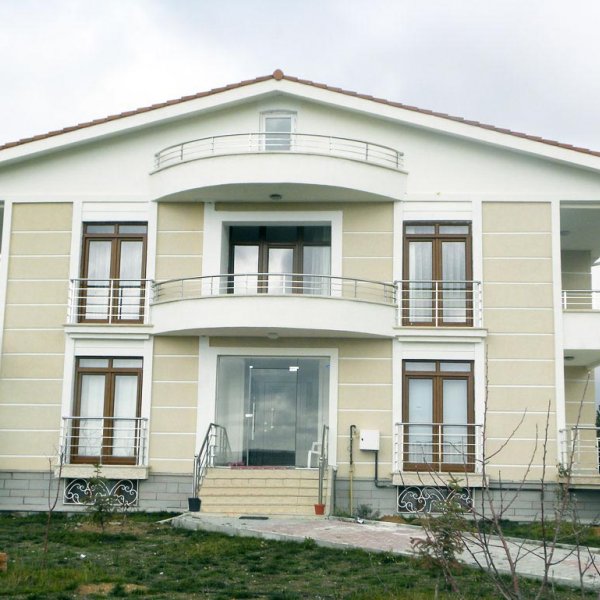Isıcam Systems C Series
Isıcam Systems C Series is the classic series that provides standard insulation and savings, produced with the assurance of Isıcam.
Advantages
Isıcam Systems are produced by Isıcam Authorized Manufacturers who are regularly audited by Şişecam Flat Glass.
Isıcam brand is in production;
- Glass and side materials are used in appropriate quality and quantity,
- It is the assurance that the production is carried out continuously under suitable conditions and using modern technologies.
Isicam Systems is under the guarantee of Isicam Authorized Manufacturer for 10 years against production-related faults.
About product
Isıcam Systems C Series is the classic series that provides standard insulation and savings, produced with the assurance of Isıcam.
Personalize Your Isicam with Additional Features
Isıcam CL:
 The Isıcam unit, produced using Şişecam Laminated Glass, which provides safety and security, prevents possible injuries by preventing the glass from scattering in case of breakage, in addition to thermal insulation.
The Isıcam unit, produced using Şişecam Laminated Glass, which provides safety and security, prevents possible injuries by preventing the glass from scattering in case of breakage, in addition to thermal insulation.
Isıcam C AL:
 The Isıcam unit, produced using Şişecam Acoustic Laminated Glass, which provides noise control, provides sound insulation in addition to thermal insulation, reducing noise transmissions, while also having the safety and security features of Şişecam Laminated Glass.
The Isıcam unit, produced using Şişecam Acoustic Laminated Glass, which provides noise control, provides sound insulation in addition to thermal insulation, reducing noise transmissions, while also having the safety and security features of Şişecam Laminated Glass.
Isicam CR:
 The Isıcam unit, produced using Şişecam Colored Flat Glass, which provides solar control, limits the solar heat entry into the building in addition to thermal insulation, controls the excessive brightness of the sun, and reduces cooling energy consumption and thus cooling costs in environments where air conditioning is used.
The Isıcam unit, produced using Şişecam Colored Flat Glass, which provides solar control, limits the solar heat entry into the building in addition to thermal insulation, controls the excessive brightness of the sun, and reduces cooling energy consumption and thus cooling costs in environments where air conditioning is used.
Isıcam C RF:
 The Isıcam unit, produced by using reflective glasses that provide solar control feature Şişecam Tentesol and Şişecam Tentesol Titanium, limits the solar heat entry into the building in addition to thermal insulation, controls the excessive brightness of the sun and reduces cooling energy consumption and thus cooling costs in environments where air conditioning is used. Due to its reflective feature, it creates a mirror effect when viewed from the direction of strong light. It provides visual integrity in commercial buildings with glass facades.
The Isıcam unit, produced by using reflective glasses that provide solar control feature Şişecam Tentesol and Şişecam Tentesol Titanium, limits the solar heat entry into the building in addition to thermal insulation, controls the excessive brightness of the sun and reduces cooling energy consumption and thus cooling costs in environments where air conditioning is used. Due to its reflective feature, it creates a mirror effect when viewed from the direction of strong light. It provides visual integrity in commercial buildings with glass facades.
Usage areas
It is used in newly built or renovated residences and commercial buildings with solar control glazing.
Technicial Specifications
Isıcam Systems is an insulating glass unit formed by combining two or more glass plates produced and/or sold by Şişecam Flat Glass in factory conditions to contain dry air or gases suitable for ambient pressure.
Performance Chart
| Performance Values | |||||||
|---|---|---|---|---|---|---|---|
| Insulating Glass Systems | Glass Combination | Daylight (EN 410) | Solar Energy (EN 410) | Thermal Permeability Coefficient (U value) W/m2K (EN 673) |
|||
| Permeability % | Projection % |
Total Permeability % |
Shading Coefficient | Weather | Argon | ||
| Isıcam Systems C Series | 4+12+4 | 80 | 14 | 75 | 0.86 | 2.9 | 2.7 |
| 4+16+4 | 2.7 | 2.6 | |||||
National / International Standards That Isicam Complies with
TS 3539 EN 1279 Glass - Used in Buildings - Glass Based Insulation Units
National / International Standards for Which Raw Materials Used Are Appropriate
- Pine
- Float TS EN 572/2
- Glasses in market and final cut sizes TS EN 572/8
- Frosted TS EN 572/5
- Tempered TS EN 1215
- Partially tempered TS EN 1863
- Laminated TS EN ISO1254
- Coated TS EN 1096
- Heat treated tempered glass EN 14179
- Other Raw Materials
- In the production of insulating glass; Butyl, polysulfide (thiokol), silicone, polyurethane, dehumidifier and interstitial strip (profile) included in the Isıcam Approved Materials List prepared by Şişecam Flat Glass are used. In case the sealants used are replaced with sealants of other brands, provided that they are included in the Isicam Approved Materials List, the substitution conditions specified in article 4.2.2 of the TS 3539 EN1279-4 standard must be fulfilled.
Insulating Glass Quality
- Isicam's Optical and Appearance Quality
- Point Defects
The optical and appearance quality of Isıcam is defined in TS EN 1279/1. Accordingly, the optical and appearance quality given in the relevant standards of the glasses that make up Isıcam is valid.
Since the appearance and quality conditions of the single plates do not exceed the maximum allowable error limit in the insulating glass unit, there is no need to seek additional conditions regarding this issue. However, a higher level of acceptance may be included in the quality agreement between the customer and the insulating glass unit manufacturer.
Detailed information on the optical and appearance quality of Isıcam, which is in its natural structure and/or due to its physical properties, is given in TS EN 1279/1 Annex C.
In Isıcam, TS EN 572/8 supply to the market and acceptance levels applied to glass in final cut dimensions are valid as a point defect.
Acceptance levels for point defects in final cut dimensions of float glass used in Isıcam:
Defect class Surface area of glass plate (S), m² S ≤ 5 5 < S ≤ 10 10 < S ≤ 20 A not sought B one 2nd 4 C inadmissible one one D inadmissible The distance between class B defects should not be less than 500 mm. Point Defect Groups
Group Size of point defect nuclei (mm) A Greater than 0.2 mm and less than or equal to 0.5 mm B Greater than 0.5 mm and less than or equal to 1.0 mm C Greater than 1.0 mm and less than or equal to 3.0 mm D Greater than 3.0mm The tolerances in the TS EN 1096 Coated glass standard are valid in the coating of Isıcam units produced with Solar Low-E, Low-E, on-line reflective solar control coated glasses produced and/or sold by Şişecam Flat Glass.
- Linear (Scratches and Scratches) Defects
The optical and appearance quality of Isıcam is defined in TS EN 1279/1. Accordingly, the optical and appearance quality given in the relevant standards of the glasses that make up Isıcam is valid.
Since the appearance and quality conditions of the single plates do not exceed the maximum allowable error limit in the insulating glass unit, there is no need to seek additional conditions regarding this issue. However, a higher level of acceptance may be included in the quality agreement between the customer and the insulating glass unit manufacturer.
Detailed information on the optical and appearance quality of Isıcam, which is in its natural structure and/or due to its physical properties, is given in TS EN 1279/1 Annex C.
As mentioned in the TS EN 572/8 glass standard for placing on the market and final cut dimensions, no linear defects are allowed.
While the observation distance is given as 2 m in the determination of both point and surface defects in the TS EN 572/8 glass standard for supply to the market and in the final cut dimensions, the observation distance will be taken as 1 m in the Isıcam standard. Therefore, the defects mentioned in TS EN 572/8 and TS EN 1096 can be considered as errors when they are detected at an observation distance of 1 m.
- Other Defects
As it is known, the separating material (lucite dust, paper, etc.) placed between the plate glasses prevents the glasses from rubbing with each other, and protects the glass surface against humidity and temperature changes. The powder or paper placed between the glasses is in a composition that will not damage the chemical structure of the glass due to its properties, and no powder or paper is used. The particle size of the powder used is as important as its chemical structure. For this reason, the paper and powder to be placed between the glasses are specially selected and used under control.
Corrosion failure occurs as a result of the condensation of moisture in the air or the deterioration of the chemical structure of the glass by wetting, in the point worn areas that will occur with the friction of the glass plates. The corrosion defect appears as white spots on the glass in the advanced stage. In the initial stage, it may not be visible to the naked eye. For this reason, it should be checked whether corrosion has started by keeping steam on the glasses from time to time at a close distance. Corrosion error is not allowed in the Isıcam unit. For this reason, care should be taken in the storage and transportation of glass packages. Especially in the winter months, when glass packages are put into operation, the package should not be opened and processed until the package temperature reaches ambient temperature.
Dust, dirt, paste smears, fingerprints, etc. on the glass plate surfaces facing the gap. should not exist.
- Point Defects
Thickness and Dimensions
Standard Thickness and Dimensions
Dimensional tolerances of Isıcam (according to EN 1279)
| Flat Glass Plate | ||
|---|---|---|
| Length | Glass Thickness | Size Tolerance |
| ≤ 3 meters | ≤ 6 millimeters | ± 2 mm |
| ≤ 3 meters | > 6 millimeters | ± 3 mm |
| > 3 meters | ≤ 6 millimeters | ± 3 mm |
| > 3 meters | > 6 millimeters | ± 4 mm |
| At least One Plate Tempered or Semi-Tempered Glass | ||
|---|---|---|
| Length | Glass Thickness | Size Tolerance |
| ≤ 3 meters | Independent of thickness | ± 3 mm |
| > 3 meters | Independent of thickness | ± 4 mm |
| At least One Plate of Laminated Glass | ||
|---|---|---|
| Length | Glass Thickness | Size Tolerance |
| ≤ 1.5 meters | ≤ 16 millimeters | ± 3 mm |
| ≤ 1.5 meters | > 16 millimeters | ± 4 mm |
| > 1.5 meters and ≤ 2.5 meters | ≤ 16 millimeters | ± 4 mm |
| > 1.5 meters and ≤ 2.5 meters | > 16 millimeters | ± 5 mm |
| > 2.5 meters | ≤ 16 millimeters | ± 5 mm |
| > 2.5 meters | > 16 millimeters | ± 6 mm |
Insulating glass unit thickness tolerances
| 1st plate | 2nd plate | Thickness tolerances |
|
|---|---|---|---|
| A | Float glass or coated glass Thickness < 6mm Thickness > 6mm |
Float glass or coated glass and thickness < 6 mm and/or thickness > 6mm |
± 1 mm ± 1,5 mm |
| B | float glass or coated glass | Tempered or semi-tempered float or coated glass | ± 2 mm |
| C | float glass or coated glass | Frosted glass | ± 1,5 mm |
| D | float or coated glass | laminated glass | ± 1,5 mm |
| AND | tempered or semi-tempered glass | tempered or semi-tempered glass | ± 2,5 mm |
| F | tempered or semi-tempered glass | Frosted glass | ± 2 mm |
| G | tempered or semi-tempered glass | laminated glass | ± 2 mm |
| H | Frosted glass | ||
.jpg)

